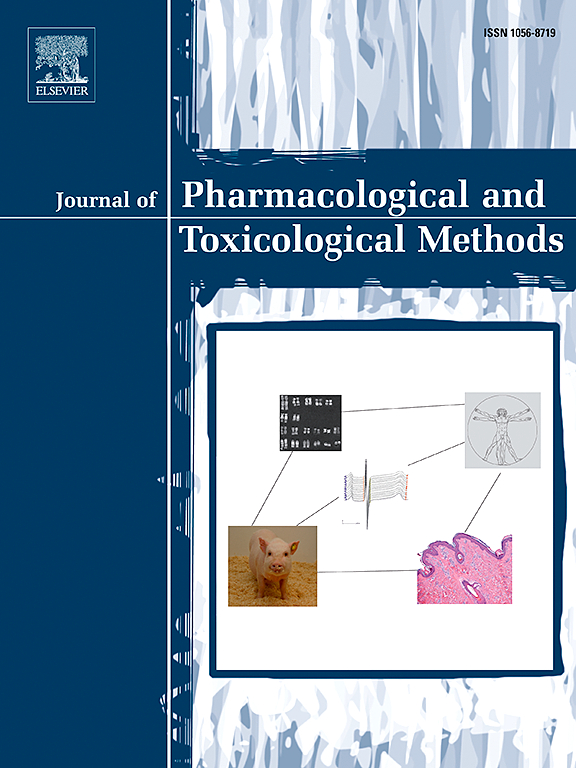Drug combination assays using Caenorhabditis elegans as a model system
IF 1.3
4区 医学
Q4 PHARMACOLOGY & PHARMACY
Journal of pharmacological and toxicological methods
Pub Date : 2025-02-01
DOI:10.1016/j.vascn.2025.107583
引用次数: 0
Abstract
The C. elegans drug combination assay evaluates the effects of drug combinations in the nematode Caenorhabditis elegans, serving as a valuable tool to assess the efficacy of pharmaceutical agents and natural compounds. Using C. elegans as a model organism, this method allows for the efficient screening of the combined effects of different drugs and evaluation of synergistic effects in drug combinations, which reduces the risk of developing drug resistance.
Combination therapy, involving commercial drugs, new agents, or natural products, broadens treatment effectiveness by targeting multiple pathways, effectively managing complex diseases with minimized side effects. The method focuses on discovering effective drug combinations, such as anthelmintic drugs, streamlining early-stage drug discovery to save time and resources. Additionally, its versatility allows for application across most areas of pharmacology and toxicology, extending its usefulness beyond anthelmintic treatments.
In the experiments, synchronized worms are exposed to different drug concentrations to evaluate behavioral changes, mostly alterations in worm locomotion. Concentration-response curves for changes in behavior are generated and EC50 or IC50 values determined for the individual drugs. To determine whether the effects of a drug combination are synergistic, additive, or antagonistic, at least three different concentration ratios must be tested. These combinations are then analyzed using specialized drug combination analysis software. This methodology ensures consistent and precise outcomes and evaluates drug impacts on worm behavior parameters crucial for effective pharmacological activity.
In conclusion, the C. elegans drug combination assay provides critical insights for developing successful market formulations applicable across a wide range of pharmacological treatments. Its ability to efficiently screen for synergistic, additive, or antagonistic effects makes it a valuable tool for identifying effective therapeutic strategies, potentially reducing drug resistance and improving treatment outcomes in various medical and toxicological fields.

以秀丽隐杆线虫为模型系统的药物联合试验。
秀丽隐杆线虫药物联合试验评估了药物联合对秀丽隐杆线虫的影响,是评估药物制剂和天然化合物功效的有价值的工具。该方法以秀丽隐杆线虫为模式生物,可以有效筛选不同药物的联合作用,并评估药物组合的协同效应,从而降低产生耐药性的风险。联合治疗包括商业药物、新药或天然产品,通过针对多种途径扩大治疗效果,以最小的副作用有效地管理复杂的疾病。该方法侧重于发现有效的药物组合,如驱虫药,简化早期药物发现,节省时间和资源。此外,它的多功能性允许在大多数药理学和毒理学领域的应用,将其用途扩展到驱虫药治疗之外。在实验中,同步的蠕虫暴露于不同浓度的药物中,以评估行为变化,主要是蠕虫运动的变化。生成行为变化的浓度-反应曲线,并确定每种药物的EC50或IC50值。为了确定药物组合的作用是增效、加性还是拮抗,必须至少测试三种不同的浓度比。然后使用专门的药物组合分析软件对这些组合进行分析。该方法确保了一致和精确的结果,并评估了药物对蠕虫行为参数的影响,这些参数对有效的药理活性至关重要。总之,秀丽隐杆线虫药物组合试验为开发适用于广泛药理治疗的成功市场配方提供了关键见解。它能够有效地筛选协同、加性或拮抗作用,使其成为确定有效治疗策略、潜在地减少耐药性和改善各种医学和毒理学领域治疗结果的有价值的工具。
本文章由计算机程序翻译,如有差异,请以英文原文为准。
求助全文
约1分钟内获得全文
求助全文
来源期刊

Journal of pharmacological and toxicological methods
PHARMACOLOGY & PHARMACY-TOXICOLOGY
CiteScore
3.60
自引率
10.50%
发文量
56
审稿时长
26 days
期刊介绍:
Journal of Pharmacological and Toxicological Methods publishes original articles on current methods of investigation used in pharmacology and toxicology. Pharmacology and toxicology are defined in the broadest sense, referring to actions of drugs and chemicals on all living systems. With its international editorial board and noted contributors, Journal of Pharmacological and Toxicological Methods is the leading journal devoted exclusively to experimental procedures used by pharmacologists and toxicologists.
 求助内容:
求助内容: 应助结果提醒方式:
应助结果提醒方式:


